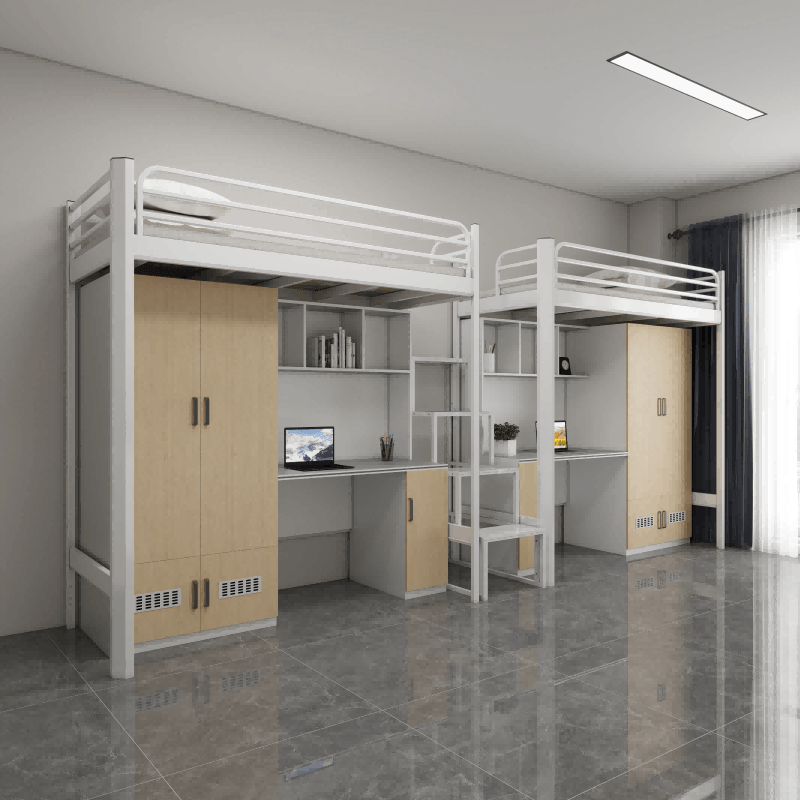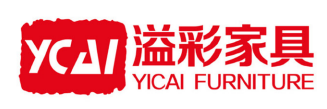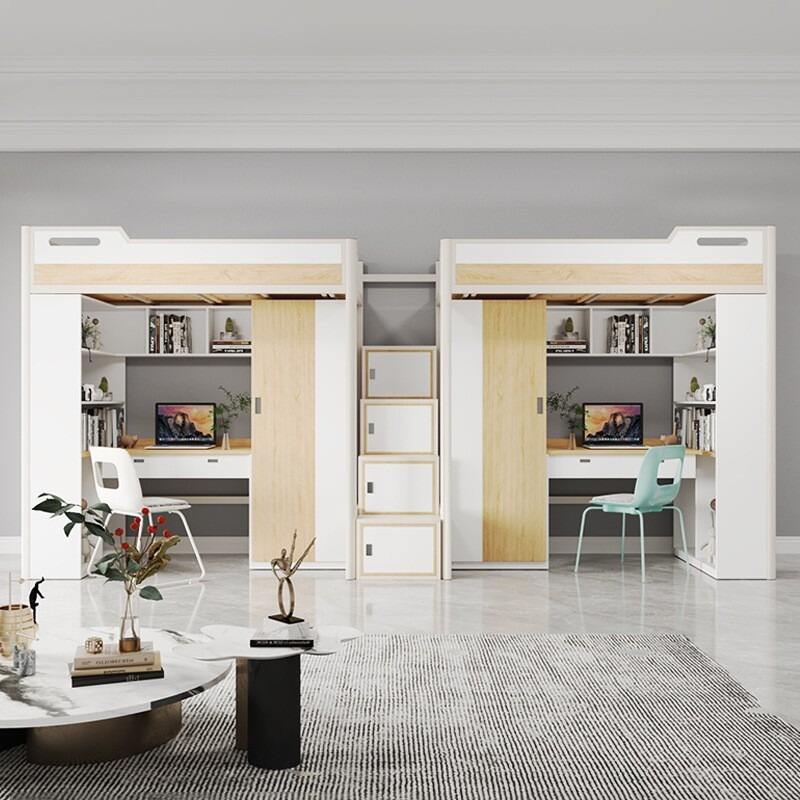Selecting the right dormitory bed is a crucial decision that impacts student comfort, study habits, and overall college experience. With limited space and strict regulations in most student housing facilities, finding the perfect balance between functionality, durability, and comfort becomes essential. A well-chosen dormitory bed serves as more than just a sleeping surface—it becomes the foundation of a student's personal sanctuary within the confines of shared living spaces.

Modern dormitory furniture has evolved significantly from basic institutional designs to sophisticated solutions that maximize space efficiency while providing superior comfort. Students today have access to innovative bed designs that incorporate storage solutions, study areas, and customizable features. Understanding the various options available helps students make informed decisions that will enhance their academic performance and personal well-being throughout their college years.
Essential Features of Modern Dormitory Beds
Space-Saving Design Elements
Contemporary dormitory bed designs prioritize vertical space utilization through loft configurations and elevated platforms. These designs create valuable floor space underneath for desks, storage units, or additional seating areas. The elevated structure allows students to maximize their limited square footage while maintaining separate zones for sleeping, studying, and socializing within their compact living quarters.
Many modern designs incorporate modular components that can be reconfigured based on changing needs throughout the academic year. Adjustable height mechanisms allow students to modify their sleeping surface elevation, creating more or less clearance underneath depending on their specific requirements. This adaptability ensures that the dormitory bed remains functional regardless of room layout changes or roommate preferences.
Built-in Storage Solutions
Integrated storage compartments have become standard features in quality dormitory bed designs, addressing the perpetual challenge of limited closet and drawer space in student housing. Under-bed drawers, side-mounted shelving units, and headboard storage compartments provide organized solutions for clothing, textbooks, and personal belongings without requiring additional furniture pieces.
Advanced storage systems include specialized compartments for electronics, charging stations, and study materials. These purpose-built storage areas help students maintain organized living spaces while keeping essential items easily accessible. The strategic placement of storage elements ensures that the dormitory bed becomes a comprehensive living solution rather than simply a sleeping arrangement.
Material Quality and Durability Considerations
Frame Construction Standards
High-quality dormitory bed frames utilize robust materials such as steel tubing or solid hardwood construction to withstand the rigorous demands of institutional use. The frame must support not only the weight of the mattress and occupant but also additional loads from storage items and occasional misuse typical in student environments. Reinforced joint connections and cross-bracing elements provide enhanced stability and prevent wobbling or structural failure.
Powder-coated finishes on metal frames offer superior resistance to scratches, chips, and corrosion while maintaining an attractive appearance throughout years of use. Wood frame options typically feature multiple coats of protective finish to resist moisture, stains, and daily wear. Quality construction standards ensure that the dormitory bed maintains its structural integrity and appearance despite frequent assembly, disassembly, and transportation between different housing assignments.
Safety Compliance Requirements
Dormitory beds must meet strict safety standards established by educational institutions and regulatory bodies to protect student welfare. Guardrail specifications for elevated beds include minimum height requirements, appropriate spacing between rails, and secure attachment mechanisms. These safety features prevent accidental falls during sleep while ensuring easy entry and exit from the sleeping surface.
Fire safety considerations influence material selection and construction methods used in dormitory bed manufacturing. Non-toxic finishes, flame-resistant materials, and proper ventilation design help minimize fire hazards in densely populated student housing facilities. Compliance with institutional safety codes ensures that students can rest peacefully knowing their sleeping arrangements meet or exceed established protection standards.
Comfort Features and Mattress Compatibility
Ergonomic Support Systems
Quality dormitory bed designs incorporate supportive slat systems or platform bases that provide optimal mattress support while promoting proper spinal alignment during sleep. The spacing and flexibility of support elements accommodate various mattress types while preventing sagging or premature wear. Proper support systems extend mattress lifespan while ensuring consistent comfort throughout the academic year.
Ventilation features built into the support system promote airflow around the mattress, reducing moisture buildup and preventing mold or mildew formation in humid dormitory environments. Strategic placement of ventilation channels helps maintain a healthy sleeping environment while extending the lifespan of both mattress and bedding materials. These features become particularly important in shared living spaces where air circulation may be limited.
Mattress Size Compatibility
Most institutional dormitory bed frames accommodate standard twin or twin XL mattress sizes, with twin XL being the preferred option for taller students. The additional length provided by twin XL mattresses offers improved comfort for students over six feet tall while maintaining the narrow width necessary for compact dormitory rooms. Compatibility with standard mattress sizes ensures easy replacement and shopping convenience.
Some advanced dormitory bed designs offer adjustable platforms that accommodate multiple mattress sizes, providing flexibility for different student preferences or institutional requirements. This adaptability allows housing departments to standardize bed frames while offering mattress size options that meet diverse student needs. The universal compatibility reduces inventory complexity while maximizing student satisfaction.
Assembly and Maintenance Requirements
Installation Process Considerations
Modern dormitory bed designs prioritize ease of assembly with clearly labeled components, pre-drilled holes, and comprehensive instruction manuals. Tool requirements are typically minimized to basic items commonly available to students, such as screwdrivers and Allen wrenches. The simplified assembly process allows students to set up their sleeping arrangements quickly during move-in periods without requiring professional assistance.
Modular construction methods enable partial disassembly for transportation while maintaining structural integrity during reassembly. Color-coded hardware and foolproof connection systems reduce assembly errors and ensure proper construction even under stressful move-in conditions. These design considerations recognize that students may need to relocate their furniture multiple times throughout their academic careers.
Long-term Maintenance Needs
Quality dormitory bed construction minimizes ongoing maintenance requirements through durable materials and robust engineering. Regular inspection of joint connections, support elements, and safety features helps identify potential issues before they compromise functionality or safety. Simple maintenance tasks such as tightening hardware connections can extend the lifespan significantly while ensuring continued safe operation.
Cleaning and care instructions for different materials help students maintain the appearance and hygiene of their sleeping arrangements throughout extended use periods. Proper maintenance protocols prevent premature wear while preserving the dormitory bed's resale value for students who plan to sell or transfer their furniture upon graduation. These considerations make quality beds a worthwhile investment in student comfort and financial well-being.
Budget Considerations and Value Assessment
Initial Investment Analysis
The initial cost of a quality dormitory bed represents a significant investment in student comfort and academic success, with prices varying based on features, materials, and brand reputation. While budget-friendly options may seem attractive, the long-term costs associated with poor durability, safety concerns, and comfort issues often exceed the savings from initial purchase price reductions. Quality construction and materials justify higher upfront costs through extended lifespan and superior performance.
Financing options and payment plans offered by many manufacturers make quality dormitory beds accessible to students with limited budgets. These programs allow students to invest in superior sleeping arrangements without compromising their financial stability during college years. The improved sleep quality and study environment provided by quality beds often translate into better academic performance, making the investment worthwhile from both comfort and educational perspectives.
Long-term Value Considerations
Quality dormitory beds retain significant resale value due to their durable construction and timeless design elements, making them attractive investments for cost-conscious students. The ability to recover a substantial portion of the initial investment through resale at graduation helps offset the higher upfront costs. Additionally, the superior durability of quality beds means fewer replacement costs and repair expenses throughout the college years.
The enhanced comfort and functionality provided by quality dormitory beds contribute to improved sleep quality, which directly impacts academic performance and overall well-being. Better rest leads to improved concentration, memory retention, and stress management—benefits that extend far beyond the monetary investment. These intangible benefits make quality beds valuable investments in student success rather than simple furniture purchases.
FAQ
What size mattress fits most dormitory beds
Most dormitory beds are designed to accommodate twin XL mattresses, which measure 38 inches wide by 80 inches long. This size provides extra length compared to standard twin mattresses while maintaining the narrow width necessary for compact dormitory rooms. Some older dormitory beds may use standard twin size mattresses, so students should verify the required dimensions with their housing department before purchasing bedding or mattresses.
How much weight can a typical dormitory bed support
Quality dormitory beds typically support between 250 to 400 pounds of total weight, including the mattress, occupant, and stored items. Loft-style beds may have lower weight limits due to their elevated design and stress distribution patterns. Students should verify weight specifications with the manufacturer and avoid exceeding recommended limits to ensure safety and prevent structural damage to their sleeping arrangements.
Are dormitory beds difficult to assemble
Modern dormitory beds are designed for easy assembly with basic tools and clear instructions. Most models can be assembled by two people within 2-4 hours using common tools like screwdrivers and Allen wrenches. Many manufacturers include all necessary hardware and provide step-by-step assembly guides with illustrations to simplify the process for students with limited construction experience.
Can dormitory beds be customized or modified
While basic dormitory bed frames offer limited customization options, many models include modular components that can be rearranged or adjusted to meet specific needs. Students can typically add compatible storage accessories, adjust height settings, or reconfigure modular elements. However, structural modifications should be avoided to maintain safety standards and warranty coverage. Always consult manufacturer guidelines before making any changes to the original design.


